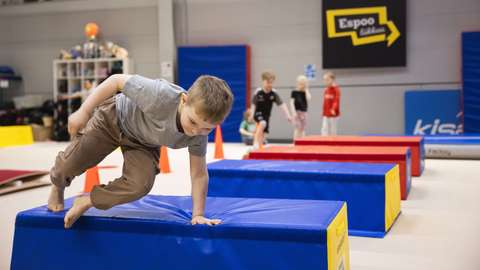Play and Move activities are developing children’s motor skills

According to the Play and Move impact survey carried out in spring 2025, Play and Move activities have developed children’s motor skills, provided experiences of success and joy in physical activity, and increased the total amount of physical activity in early childhood education and care.
Implementation of the survey
The impact survey for Play and Move activities was implemented in cooperation with the City of Espoo Mayor’s Office and early childhood education and care (ECEC). The working group did its planning in autumn 2024, the survey was carried out in spring 2025 and the results were available in May 2025.
The impact survey was sent to the staff of the ECEC groups participating in the activities and to instructors from the clubs arranging the activities. A total of 134 responses were received from ECEC (82%, n=163) and 16 from clubs (77%, n=21).
Objective of the survey
Kyselyn tavoitteena oli saada tietoa siitä, onko Leiki ja liiku -toiminta kehittänyt lasten motorisia, sosiaalisia ja kognitiivisia taitoja, The objective of the survey was to obtain information on whether the Play and Move activities have developed the children’s motor, social and cognitive skills, increased the total amount of physical activity, provided experiences of success and the joy in physical activity, and strengthened the competence of ECEC staff.
Results of the survey
In the survey, the respondents assessed how well a group of statements described factors related to the impact of Play and Move activities. The assessment was on a scale of 1–5 (1=Completely disagree, 5=Completely agree). According to ECEC staff, the statements that best describe the impact of Play and Move activities are “The children experience success during the activities” (average score: 4.35), “The joy of physical activity is visible” (average score: 4.34) and “The children get out of breath during the activities” (average score: 4.16). The majority of ECEC staff also felt that “Play and Move activities have developed the children’s motor skills” (average score: 3.97).
“The children enjoy being active in a big, new sports hall, and the joy of physical activity is evident. The instructors are inspiring and encourage children in a wonderful way,” commented the ECEC staff.
According to the instructors, the statements that best describe the impact of Play and Move activities are “Play and Move activities have developed the children’s motor skills” (average score: 4.81), “The joy of physical activity is visible” (average score: 4.69), “The children experience success during the activities” (average score: 4.63) and “The children have learned new skills during the activities” (average score: 4.63).
Both ECEC staff and the instructors from clubs estimated that the Play and Move activities had the least impact on developing children’s social and cognitive skills. Another aim in the future is for the ECEC staff to learn even more new things during the Play and Move activities and utilise what they have learned in their own work in early childhood education and care.
“We’re particularly pleased that, based on the responses, the Play and Move activities have not replaced the group’s other physical activity sessions. Instead, they complement the other physical education taking place in ECEC,” says Sports Planner Maija Pelttari, who coordinates the Play and Move activities. “It was also gratifying to notice that many respondents emphasised the work community's positive attitude as an important factor in terms of facilitating participation in the activities. Arranging for children aged 5–6 years to leave their day-care centre and participate in the activities often requires cooperation across group boundaries, so commitment on the part of the entire work community is crucial to making the activities possible.”
The responses to the survey highlighted skills that the respondents reported that the children had learned in the Play and Move activities.
In general, the respondents are satisfied with the Play and Move activities, as ECEC provided an overall grade of 3.90 for the activities (on a scale of 1–5, where 1=Completely disagree and 5=Completely agree).
“A wonderful variety of tasks and activities. Lots of things that we simply can’t organise in our own unit. The activities gradually become more complex, the children learn new skills in a cumulative manner,” comments the ECEC staff.
The results of the impact survey have been utilised during planning of the autumn season and will continue to be actively utilised to develop the activities. The aim is to further expand the Play and Move activities, to involve an increasing number of Espoo-based children, and to create a permanent physical activity model that promotes well-being and a physically active lifestyle for children.
Read more about Play and Move activities on our website.